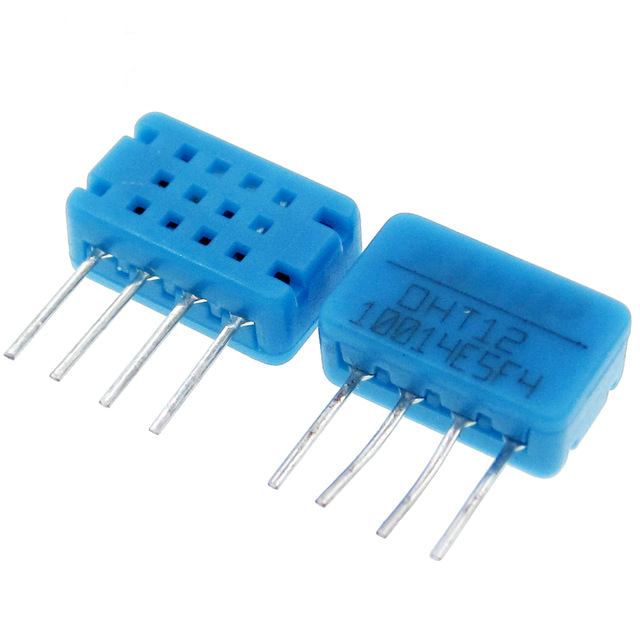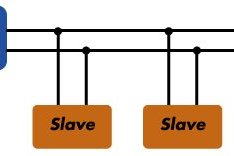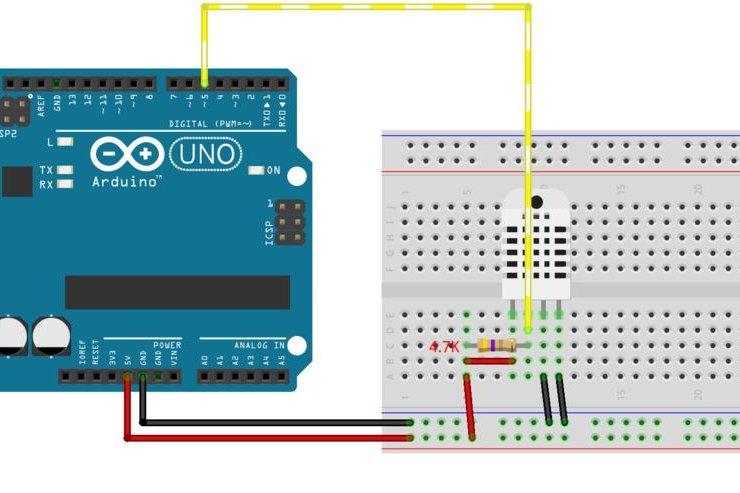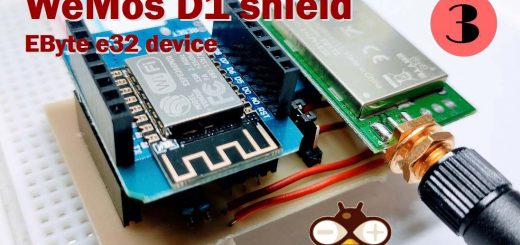DHT12 i2c Cheap Humidity and Temperature Sensor

I like a sensor that can be used with two wires (i2c protocol), but I love the inexpensive one.
This is an Arduino and esp8266 library for the DHT12 series of very low-cost temperature/humidity sensors (less than 1$) that work with i2c or one wire connection.

Very usefully if you want use esp01 (if you use serial you have only 2 pin) to read humidity and temperature and display it on i2c LCD.
AI read that sometime seems that need calibration, but I have tree of this and get value very similar to DHT22. If you have calibration this problem, open issue on github and I add implementation.

How I2c Works
I2C works with it’s two wires, the SDA(data line) and SCL(clock line).
Both these lines are open-drain, but are pulled-up with resistors.
Usually there is one master and one or multiple slaves on the line, although there can be multiple masters, but we’ll talk about that later.
Both masters and slaves can transmit or receive data, therefore, a device can be in one of these four states: master transmit, master receive, slave transmit, slave receive.
Library
I write a library because I can’t find a library that support 1-wire and i2c correctly. You can find my library here.
To download.
Click the DOWNLOADS button in the top right corner, rename the uncompressed folder DHT12.
Check that the DHT folder contains DHT12.cpp and DHT12.h.
Place the DHT library folder your /libraries/ folder.
You may need to create the libraries subfolder if its your first library.
Restart the IDE.
Behaivor
This library tries to emulate the behavior of standard DHT library sensors (and copy a lot of code), and I add the code to manage i2c also in the same manner.
The method is the same of DHT library sensor, with some adding like dew point function.
I2c usage
To use with i2c (default address and default SDA SCL pin) the constructor is:
DHT12 dht12;
and take the default value for SDA SCL pin.
(It’s possible to redefine with specified contructor for esp8266, needed for ESP-01). or
DHT12 dht12(uint8_t addressOrPin)
addressOrPin -> address
to change address.
Second channel i2c usage [update 28/04/2019]
To use it with a second i2c channel, as for esp32 I added some variations to the constructors that are activated for esp32 environment (thanks to issb-gh).
TwoWire I2Ctwo = TwoWire(1);
DHT12 dht12(&I2Ctwo);
//DHT12 dht12(&I2Ctwo, 21,22);
//DHT12 dht12(&I2Ctwo, 0x5C);
//DHT12 dht12(&I2Ctwo, 21,22,0x5C);
As you can see, all the standard parameters can be found, but in addition you will find the parameter that allows you to pass the specific Wire instance.
One Wire Usage
To use one wire:
DHT12 dht12(uint8_t addressOrPin, true)
addressOrPin -> pin
boolean value is the selection of oneWire or i2c mode.
Implicit Read
You can use It with “implicit”, “simple read” or “fullread”: Implicit, only the first read doing a true read of the sensor, the other read that become in 2secs. interval are the stored value of first read.
// Reading temperature or humidity takes about 250 milliseconds!
// Read temperature as Celsius (the default)
float t12 = dht12.readTemperature();
// Read temperature as Fahrenheit (isFahrenheit = true)
float f12 = dht12.readTemperature(true);
// Sensor readings may also be up to 2 seconds 'old' (its a very slow sensor)
float h12 = dht12.readHumidity();
bool dht12Read = true;
// Check if any reads failed and exit early (to try again).
if (isnan(h12) || isnan(t12) || isnan(f12)) {
Serial.println("Failed to read from DHT12 sensor!");
dht12Read = false;
}
if (dht12Read){
// Compute heat index in Fahrenheit (the default)
float hif12 = dht12.computeHeatIndex(f12, h12);
// Compute heat index in Celsius (isFahreheit = false)
float hic12 = dht12.computeHeatIndex(t12, h12, false);
// Compute dew point in Fahrenheit (the default)
float dpf12 = dht12.dewPoint(f12, h12);
// Compute dew point in Celsius (isFahreheit = false)
float dpc12 = dht12.dewPoint(t12, h12, false);
Serial.print("DHT12=> Humidity: ");
Serial.print(h12);
Serial.print(" %\t");
Serial.print("Temperature: ");
Serial.print(t12);
Serial.print(" *C ");
Serial.print(f12);
Serial.print(" *F\t");
Serial.print(" Heat index: ");
Serial.print(hic12);
Serial.print(" *C ");
Serial.print(hif12);
Serial.print(" *F");
Serial.print(" Dew point: ");
Serial.print(dpc12);
Serial.print(" *C ");
Serial.print(dpf12);
Serial.println(" *F");
}
Simple Read
Simple read to get a status of read.
// The read of sensor have 2secs of elapsed time, unless you pass force parameter
bool chk = dht12.read(); // true read is ok, false read problem
// Read temperature as Celsius (the default)
float t12 = dht12.readTemperature();
// Read temperature as Fahrenheit (isFahrenheit = true)
float f12 = dht12.readTemperature(true);
// Sensor readings may also be up to 2 seconds 'old' (its a very slow sensor)
float h12 = dht12.readHumidity();
// Compute heat index in Fahrenheit (the default)
float hif12 = dht12.computeHeatIndex(f12, h12);
// Compute heat index in Celsius (isFahreheit = false)
float hic12 = dht12.computeHeatIndex(t12, h12, false);
// Compute dew point in Fahrenheit (the default)
float dpf12 = dht12.dewPoint(f12, h12);
// Compute dew point in Celsius (isFahreheit = false)
float dpc12 = dht12.dewPoint(t12, h12, false);
Full Read
Full read to get a specified status.
// The read of sensor have 2secs of elapsed time, unless you pass force parameter
DHT12::ReadStatus chk = dht12.readStatus();
Serial.print(F("\nRead sensor: "));
switch (chk) {
case DHT12::OK:
Serial.println(F("OK"));
break;
case DHT12::ERROR_CHECKSUM:
Serial.println(F("Checksum error"));
break;
case DHT12::ERROR_TIMEOUT:
Serial.println(F("Timeout error"));
break;
case DHT12::ERROR_TIMEOUT_LOW:
Serial.println(F("Timeout error on low signal, try put high pullup resistance"));
break;
case DHT12::ERROR_TIMEOUT_HIGH:
Serial.println(F("Timeout error on low signal, try put low pullup resistance"));
break;
case DHT12::ERROR_CONNECT:
Serial.println(F("Connect error"));
break;
case DHT12::ERROR_ACK_L:
Serial.println(F("AckL error"));
break;
case DHT12::ERROR_ACK_H:
Serial.println(F("AckH error"));
break;
case DHT12::ERROR_UNKNOWN:
Serial.println(F("Unknown error DETECTED"));
break;
case DHT12::NONE:
Serial.println(F("No result"));
break;
default:
Serial.println(F("Unknown error"));
break;
}
// Read temperature as Celsius (the default)
float t12 = dht12.readTemperature();
// Read temperature as Fahrenheit (isFahrenheit = true)
float f12 = dht12.readTemperature(true);
// Sensor readings may also be up to 2 seconds 'old' (its a very slow sensor)
float h12 = dht12.readHumidity();
bool dht12Read = true;
// Check if any reads failed and exit early (to try again).
if (isnan(h12) || isnan(t12) || isnan(f12)) {
Serial.println("Failed to read from DHT12 sensor!");
dht12Read = false;
}
if (dht12Read){
// Compute heat index in Fahrenheit (the default)
float hif12 = dht12.computeHeatIndex(f12, h12);
// Compute heat index in Celsius (isFahreheit = false)
float hic12 = dht12.computeHeatIndex(t12, h12, false);
// Compute dew point in Fahrenheit (the default)
float dpf12 = dht12.dewPoint(f12, h12);
// Compute dew point in Celsius (isFahreheit = false)
float dpc12 = dht12.dewPoint(t12, h12, false);
Serial.print("DHT12=> Humidity: ");
Serial.print(h12);
Serial.print(" %\t");
Serial.print("Temperature: ");
Serial.print(t12);
Serial.print(" *C ");
Serial.print(f12);
Serial.print(" *F\t");
Serial.print(" Heat index: ");
Serial.print(hic12);
Serial.print(" *C ");
Serial.print(hif12);
Serial.print(" *F");
Serial.print(" Dew point: ");
Serial.print(dpc12);
Serial.print(" *C ");
Serial.print(dpf12);
Serial.println(" *F");
}
Connection Diagram
With examples, there are the connection diagram, it’s important to use correct pullup resistor.
Thanks to Bobadas, dplasa and adafruit, to share the code in github (where I take some code and ideas).















hello great guide!
a question: is it possible to connect many(4-6) dht12 to one digital pin? if so how?
can you help ?
thanks for help
Hi Gigio,
thanks,
no, you can connect more dht12 but one every Digital PIN, and one for i2c bus.
Bye Renzo
dht12.readTemperature() should be dht12.getTemperature()
and
dht12.readHumidity() should be dht12.getHumidity.
Sorry, but this is a clone of Adafruit DHT sensor library, and they use read
Here the example
Bye Renzo